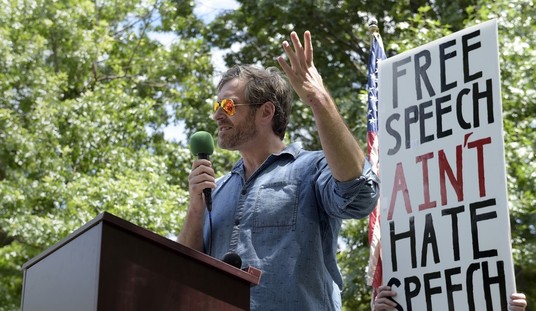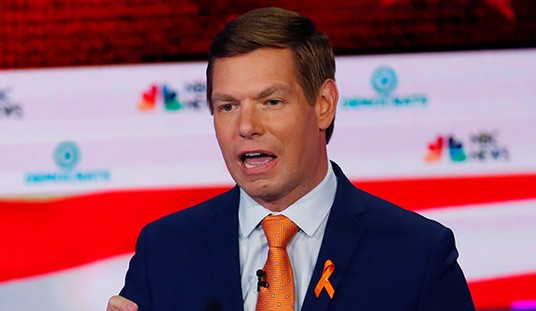A mob of pro-Russian protesters savagely attacked a pro-Ukrainian rally with clubs, metal rods, rocks, tear gas, and smoke bombs, killing a 22-year-old local man and seriously injuring scores of others Thursday in Lenin Square in Donetsk, an industrial city in eastern Ukraine.
According to witnesses, the pro-Ukrainian rally consisted mostly of local men and women, some with children, who came there after work to support the territorial integrity of Ukraine against Russia’s attempts to split the country. This angered a pro-Russian rally nearby, which held Russian flags and demanded that the coal-mining region be separated from Ukraine and joined with Russia.
At some point rocks, eggs, and smoke grenades started flying from the pro-Russian side towards a line of people who chanted Ukrainian slogans while holding a long banner with the colors of the Ukrainian flag. As the rally ended, a large crowd of angry Russian nationalists surrounded their opponents, hurling ethnic insults, and preventing them from leaving. The confrontation quickly became violent.
A slide show on this Ukrainian news site has the pictures. A 25-minute YouTube video, posted the same day by a local citizen reporter, shows uninterrupted footage of the most violent stage of the riot, helping to reconstruct the events.
As the police succeeded in letting most of the pro-Ukrainian side leave the square, they themselves got surrounded by an angry mob, with about twenty bloodied people huddled together next to a police bus inside a protective circle of policemen. The law enforcement, represented by both local and military police, was outnumbered; an officer was heard calling for reinforcement.
The crowd chanted “Russia! Russia!” while also screaming threats, insults, and ethnic slurs. They also chanted “On your knees,” demanding that the Ukrainian patriots kneel before their tormentors, who waved Russian flags.
As rocks, bottles, and smoke bombs continued to fly, the police managed to get the battered men into the bus, but the attackers slashed the tires and broke the windows, throwing more rocks and smoke bombs inside the bus, spraying pepper spray and forcing the people out into the street.
As the pro-Ukrainian demonstrators climbed out of the bus windows back into the street, the crowd broke the police barrier and began to beat up the unarmed men with fists and clubs, leaving several of them lying on the pavement, covered in blood, all the while calling their victims “fascists” and “faggots.” A few who tried to escape by breaking through the crowd were surrounded and beaten.
The chant “On your knees!” continued as the surrounded and beaten people, many of them unable to stand, crouched on the ground, which the mob finally perceived as compliance with their demand to kneel. Having carried the wounded away, the police were finally able to escort the remaining few to safety.
The video ends with the camera pointing downwards, as one of the pro-Russian attackers demands that the cameraman stop shooting because the footage may wind up in the “wrong” hands. During the time of this writing this video added half a million views on YouTube, with many comments in both Russian and broken English cheering the beating of Ukrainians and blaming America for the violence.
In another video, which shows an injured man being taken to an ambulance, gloating voices refer to him as a “Bandera” (a slur against Ukrainian nationalists) and an intruder from Maidan who got what he deserved for taking American money. This and other comments in the videos, as well as multiple pro-Russian comments on various YouTube threads, reveal a paranoid, hateful mind-set, which boils down to the following presumptions:
(a) The Ukrainian revolution was the result of a vast Western-Zionist conspiracy against Russia; (b) all pro-Ukrainian demonstrators are violent Nazis, fascists, and traitors who have been paid with dollars by their American, European, and Zionist masters; and (c) the demonstrators are all intruders from Western Ukraine, the land of hateful worshipers of the “Nazi collaborator” Stepan Bandera
Such absurd beliefs are the result of a massive campaign of lies, distortions, provocations, and propaganda that the Putin government has been disseminating through all available media channels, both inside Russia and in the Russian-speaking areas of Ukraine, aiming to discredit and demonize the recent popular uprising against the corrupt pro-Russian government of Victor Yanukovich. Among the various reasons to suppress the Ukrainian revolution, probably the most important one was the Kremlin’s fear that it may soon spread from Maidan to Red Square.
After the Maidan uprising finally succeeded on February 22, the propaganda only intensified, with an added focus on stirring separatist sentiments and paranoia in the Russian-speaking regions of Ukraine, with the apparent goal of breaking the country apart in order to destabilize, demoralize, and subdue the new Ukrainian government – or, better yet, to absorb the breakaway regions into Russia.
The same propaganda, in a more subtle and less anti-Semitic form, has found its way to the West — first through the usual hard-left and “anti-war” channels, as well as a hired army of trolls posting anti-Ukrainian and pro-Russian comments on the Internet and social media; then through more established news media and talk radio.
An important part in this has always been played by RT, or Russia Today — the second most-watched foreign news channel in the U.S. after BBC World News and the number one foreign station in five major U.S. urban areas, boasting on its Wikipedia page about being “very popular among younger American people, U.S. college students, and in U.S. inner city neighborhoods.”
Reporting on today’s violence in Donetsk, for example, RT predictably blamed the violence on the pro-Ukrainian side, who allegedly provoked the Russian nationalists “by shouting far-right slogans ‘Glory to Ukraine’ and ‘Glory to heroes,’ loudly demanding the respect of Ukrainian territorial sovereignty.” In that statement alone, preemptively disseminating the “correct” narrative, the RT editors revealed the unmasked voice of pervasive Russian chauvinism: how dare Ukrainians be patriotic and stand up for Ukraine while in their own country?
The important part of the story is that both the attackers and the attacked spoke Russian, which is the native tongue for the majority of people in eastern parts of Ukraine. Similarly, many speakers in Kiev’s Maidan and a large number of anti-government protesters also spoke Russian and carried Russian-language signs. Admittedly, the majority of Russian speakers in Ukraine think of themselves as Ukrainians, and favor independence from Russia and the territorial integrity of their country.
Why would one group of Ukrainians attack another group of Ukrainians for espousing allegiance to their common country?
To be sure, this isn’t a conflict between Ukrainians and Russians, or between the Ukrainian-speaking and the Russian-speaking citizens of Ukraine, no matter how much the Kremlin desires to turn it into one. It is a conflict of two mindsets, two ideologies, and two allegiances. One side is nostalgic for the old Soviet era with its imperial, autocratic , and collectivist mode of existence. The other side desires freedom, individual rights, and the dignity of living outside of Russia’s shadow.
In addition, according to local sources in Donetsk, there was evidence that at least some of the attackers, who shouted at the local Ukrainians to “go home,” themselves had been intruders from the neighboring Russia. It is hardly a coincidence that during pro-Russian actions in Donetsk all local hotels were occupied by young visitors from Russia, while the separatists posing as Ukrainian citizens weren’t familiar with the name of the local governor, Andrei Shishatsky.
This wasn’t their first riot, either. On March 1, a 7,000-strong pro-Russian separatist rally in the same Lenin Square in Donetsk marched on the office of the regional government, took down the Ukrainian flag on its spire and raised the flag of Russia instead.
Earlier they demanded that the Donetsk region split from Ukraine and join Russia, declared the new Ukrainian government illegitimate, refused to obey the newly appointed local governor, and elected a local populist leader, Pavel Gubarev, as “the people’s governor.”
Gubarev then declared that the local law enforcement and military units must obey his orders and compared himself to the Venezuelan Marxist dictator Hugo Chavez, as well as such autocratic leaders as Belarus president Lukashenko, Russian president Putin, and Kazakhstan president Nazarbayev, adding that the future belongs to the Eurasian Union, which is based on the authoritarian model of government.
A speaker at a Maidan rally in Kiev later described these events, suggesting that the only way for the Ukrainian patriots to stop such Russian intruders from going to Ukrainian cities, inciting separatism, and tearing down Ukrainian flags with impunity was to start shooting them so they begin to respect another country’s sovereignty.
A video of that speech soon went viral in Russia. Taken without context, a claim that Ukrainian protesters now want to start shooting Russians stirred a wave of indignation among Russian nationalists. It is easy to imagine that part of this indignation translated in today’s beatings of local pro-Ukrainian demonstrators in Donetsk, whom the pro-Russian attackers imagined to be “murderous intruders” in the service of “Western imperialism.”
So far, however, the only people killed and maimed were those on the Ukrainian side. In the meantime, anti-Ukrainian propaganda and the incitement of ethnic hatred by the Kremlin continues unabated at home and in many languages abroad, creating pre-conditions for more military incursions to “protect” ethnic Russians from “Ukrainian violence.”
In a predictable development, the Russian Foreign Ministry just issued a statement saying that the new Kiev government is unable to control the situation in Ukraine and, therefore, Moscow reserves the right to protect its “fellow citizens” on the Ukrainian territory.









Join the conversation as a VIP Member